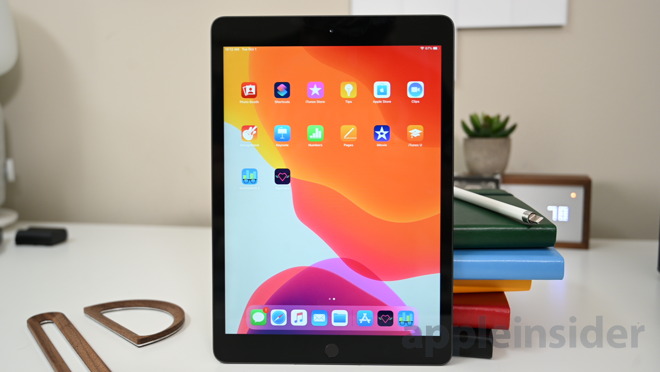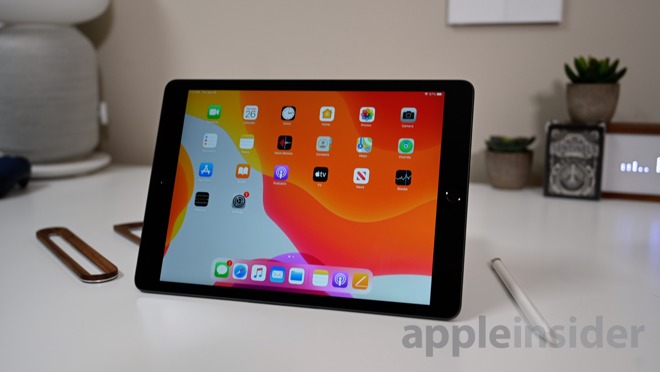Almost a footnote to the iPhone 11 and iPhone 11 Pro, Apple announced the new seventh generation 10.2-inch iPad for 2019 at its "By innovation only" event. The new iPad isn't revelatory, and is an enlargement of an iteration that Apple delivered in 2018 with the education-focused sixth-generation iPad.

The new 7th-generation iPad
Right off the top, the seventh generation has the same build quality, solidity, and ease of use as the previous generations.
Just like it was over a year ago after Apple's spring 2018 event, AppleInsider telling you about an iPad and what it can do for you is a waste of time. The odds are pretty good you're reading this review on one.
Instead, we're going to look at what sets the new iPad apart from older gear.
What's the same?
Non-laminated displayBased on what we've been hearing from users, the biggest complaints about the iPad are the re-use of the A10 processor that Apple used for the sixth-generation iPad and the non-laminated screen.
For the screen, every other generation of iPad plus the iPad Air used a non-laminated screen, so upgraders from a very old iPad or even the fifth generation from two and a half years ago will have the same screen that they've always had. They'll have a better one if they're coming from the original non-retina iPad or the immensely popular iPad 2.

The iPad still has a non-laminated display
Apple decided in 2017 to use the non-laminated screen going forward with the lower-end of the product line, and 2019 is no different. The slimming laminated display is on the iPad Pro, iPad Air, and iPad mini -- all more expensive than the seventh generation iPad.
Given the educational focus of the seventh generation iPad, there is clearly an advantage to the non-laminated screen from a service standpoint. If the glass breaks on the new iPad, it no longer necessitates a multi-hundred-dollar whole-screen replacement.
There were complaints in 2017, carried forward to 2019, that the lack of a laminated screen detaches users from the interface. We aren't going to deny that the laminated screen is nicer, but from an operational standpoint, the non-laminated screen induces no lag or delay in user input -- nor has it ever.
Also as with the 2018 iPad, the display is not a Wide Color with True Tone display, like in the iPad Pro, nor should anyone have ever expected it to be. However, color fidelity is the same as the iPad has always had, prior to Apple's enhancements for the 9.7-inch iPad Pro.
A10 processor
In regards to the A10 processor, Apple told us while demoing the unit that it not just twice as fast as competing PC laptops, but also twice the speed the previous sixth-generation iPad. Even when pressed about it, they repeated this refrain about the difference between the sixth generation iPad and the seventh several times, very specifically. We were very skeptical of this claim.
The 7th-gen iPad gets a 697 and 1397 in the Geekbench 5 test
Turns out we were right to be so, despite the new iPad having more application RAM. In Geekbench 5.0 testing, the new iPad got a single-core score of 697 and a multi-core 1397. The sixth-generation delivers 692 and 1367. That's no difference at all, so why they repeated this mantra isn't at all clear to us. We'll chalk it up to confused and revised marketing messages not getting promulgated correctly on the floor.
There's another implication of the A10 used in this iPad, and the A9 used in the fifth-generation iPad, though. Apple likes supporting an A-series processor in iOS for five years since the release of a product that last used it.
So, in this case, that means that A9 devices like the iPhone SE and iPhone 6s, and A10 devices like the iPhone 7 are likely going to be supported for a long time -- two more years at least on the former, and now five more years for the iPhone 7.
Apple Pencil support
Responsiveness from the first generation Apple Pencil on the seventh generation iPad is about the same as it is on the original 12.9-inch iPad Pro -- meaning pretty great. Our artists that we tapped to test it out still liked it just a hair better on the 2017 iPad Pro lineup, and far more than any Android equivalent that they had tried to that point.
First-generation Apple Pencil support
But, they preferred the second-generation Apple Pencil on the iPad Pro to the first generation. Even with the adapter included with the Apple Pencil, charging the stylus is awkward, and much more refined on the new Apple Pencil.
Two speakers
Charitably, iPad speakers are adequate. Physics applies here, and the iPad simply lacks room for large speaker chambers. The 2019 iPad has two speakers, like last year's model -- with the iPad Pro having four.
7th-gen iPad speakers
To test the speakers, we again did a blind test with 10 participants of varying ages. Without telling the participants which hardware they were listening to, we played back an assortment of tracks on an iPad mini 2, iPad Air, iPad Air 2, 2018 12.9-inch iPad Pro, and the 2019 iPad including audio books purchased from iTunes. The tracks we used were streamed from Apple Music.
Out of our 10 testers, at three feet, three identified the four speaker iPad Pro as having better quality, with the remainder calling the difference too close to tell between the four-speaker iPad Pro, the iPad Air 2, and the 2018 iPad. At eight feet, none of our testers could tell the difference.
Connectivity
The connectivity suite remains the same. Bluetooth is still version 4,2, Wi-Fi is still 802.11ac, and the wired connector is still Lightning.
In the real world, we're not seeing any faster web page loads than we did with the sixth-generation iPad. This is as much a testament to that device from 2017, as it is a comment on the seventh generation iPad.
Cameras
We're only making a slight nod in this direction. The cameras are identical to those on the fifth generation iPad, and are functional. They aren't nearly as good as the cameras on even the iPhone 6 -- but they aren't intended to be.
7th-gen iPad camera
Picture quality between the 2018 iPad, the 2017 iPad, the 9.7-inch iPad Pro, the first generation 12.9-inch iPad Pro, and the iPad Air 2 are essentially indistinguishable.
What's different
Screen resolutionThe stand-out feature of the seventh generation iPad is the larger 10.2-inch screen. The new display has a resolution of 2160x1620 pixels at 264 pixels per inch. In our testing, we got a brightness of about 482 nits on the seventh generation unit.
Multitasking is better with a bigger screen and iPadOS
The sixth generation iPad from 2018 has the same pixels per inch, giving it a 2048x1546 resolution, with about the same brightness as the new model.
The new iPad Pro models deliver the same pixels per inch, but more brightness. Our 12.9-inch iPad Pro from 2018 delivered about 584 nits, in a Wide Color with True Tone display -- which the seventh generation does not have.
Dimensions
With that larger screen, comes a bigger iPad enclosure.The new unit is 250.6m tall, 174.1mm wide, and 7.5 mm thick. It weighs 483 grams with Wi-Fi only, and the LTE model weighs 493 grams. For comparison, the 2018 iPad is 240mm tall, 169.5mm wide, has a thickness of 7.5mm, and weighs 469 grams with Wi-Fi and 478 grams with LTE.
To keep this all in perspective the original iPad was 242.8mm tall, 189.7mm wide, 13.4mm thick, and came in at 680 grams.
Smart connector
The seventh generation 10.2-inch iPad is the first entry-level model to support the Smart Connector. That also means that it can use Apple's Smart Keyboard for the first time.
7th-gen iPad Smart Connector
To us, the Smart Connector is potential unrealized. When it debuted on the iPad Pro line, we envisioned a large variety of peripherals and use cases for the connector, but so far, none of these have materialized, and we're not seeing many signs of this improving.
Repetita iuvant
The new iPad repeats nearly every cue, and follows very closely in the footsteps of the the 2017 and 2018 iPad in all but screen size. All three are the closest thing we've seen from Apple that approaches the lower end of the tablet market.
Again, the new iPad isn't going to revolutionize education any more than the technology as a whole may or may not have already. It still isn't cheap enough to really draw in administrators already dealing with tight education budgets, but more importantly, it isn't making educational content any cheaper.
2019 7th-gen iPad
Also again, despite Apple's educational focus, the seventh iPad still excels and is aimed at people with older iPads, in an effort to convince them to get a new device. The 2018 sixth generation iPad is an inexpensive entry-level device, that keeps on hitting the target that it zeroed in on more than two years ago with the fifth generation iPad.
If you have the iPad Air 2 or older, or the 9.7-inch iPad Pro and are looking to upgrade, the 2018 sixth generation iPad is unquestionably a good buy. Realize, though, that if you have the iPad Air 2 or that first generation 9.7-inch iPad Pro, you'll lose the laminated display -- but the better performance may be worth it.
But, if you have the fifth generation iPad, and certainly the sixth generation, there may not be enough here to upgrade unless you really want that bigger screen. Had Apple shifted to the A11 processor, this would be a different conversation, though.
Like early last year, those looking for Apple's mightiest iPad regardless of cost just need to sit this one out.
Score: 4 out of 5
Pros
- Entry-level price.
- Smart connector.
- Everything you liked about the sixth generation iPad, just bigger.
Cons
- We'd rather the seventh generation iPad use the A11, not the A10.
- None of your old cases fit.
- If you're used to a laminated display, this is a step backwards
Deals on Apple's new 10.2-inch iPad
Instant discounts on Apple's new 2019 iPad are already available, with Amazon knocking $30 off 128GB Wi-Fi models at press time.
For the latest deals and product availability, be sure to check out the AppleInsider 10.2-inch iPad Price Guide, which is updated daily.
